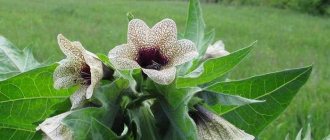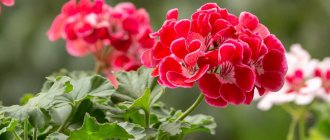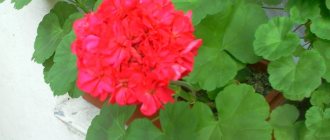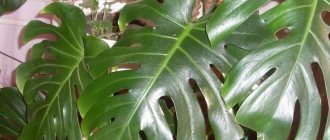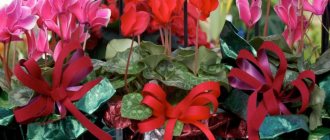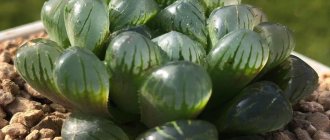The largest collection of plants classified as araceae is located in the Botanical Garden of the American state of Missouri.
Despite the many years of collecting activity of the scientific team and the research work carried out here, it has not yet been possible to plant and grow all representatives of the araceae. Yes, this is probably impossible. The largest family, according to the existing classification, today includes 113 genera and almost two thousand species. The main part of these plants, among which there are tree-like and herbaceous specimens, epiphytes and swamp inhabitants, lianas, giant and tiny varieties, live in subtropical and tropic conditions. But there are also species that prefer to settle in temperate climates, inhabiting rather harsh areas, even to the subarctic regions.
The history of the study and description of aroids began in the Middle Ages. Theophrastus was the first to mention individual plants of this family in written works, but until the 16th century there were no attempts to classify or combine closely related species. Only in 1789 did Antoine Laurent de Jussier, in describing his own view of plant families, declare the existence of common features of aroids.
Heinrich Wilhelm Schott made a serious contribution to the classification of the family, publishing a number of works on this issue in the mid-19th century. But Schott’s approach was based on external similarity, so in 1876 and later, in 1920, the system received a lot of refinements based on the structure of plants and other morphological characteristics. It is interesting that scientists still cannot achieve unity, so a number of plants and entire species sometimes change their affiliation and their names.
So what are aroid plants? What common features do they have, and what types are familiar to gardeners who are passionate about decorative indoor crops?
Alocasia
In the natural conditions of the tropics, alocasia reaches gigantic sizes.
Alocasia (Alocasia) - Arum, Elephant's ear, an evergreen plant, hardy and fast growing in indoor conditions, native to the islands of the Indian and Pacific oceans.
At home, they mainly grow Alocasia macrorrhiza and Alocasia sanderiana, from the island of Ceylon - they grow quickly, form 4-5 large arrow-shaped leaves, bright green, on long succulent petioles. Alocasia juice is poisonous.
Alocasia in a tropical garden. Photo: Online Plant Guide
Rules of care and reproduction
- Alocasia is propagated vegetatively - by suckers, eyes, cut out with part of the pulp surrounding the eye. Alocasia offspring quickly take root in warm greenhouses.
- Alocasia can be propagated by seeds, but this is a troublesome process that does not guarantee results.
Alocasia seeds are obtained from berries. Photo: Plantgasm - Alocasia requires fertile soil consisting of humus, peat and turf (2:2:1) soil.
- Alocasia is kept at a temperature of +21 °C in the summer, with plenty of watering. The temperature in winter is not lower than +17 °C.
- In cloudy and rainy weather, drops of moisture are released at the ends of alocasia leaves.
Aroid plants: what are they?
Most plants of the araceae family are distinguished by the almost complete absence of true stems, whose functions are performed by modified rhizomes.
The only exceptions are vines, which, thanks to their tenacious aerial roots, easily climb vertical surfaces and colonize larger plants. It is interesting that such aerial roots, as in one of the varieties of epipremnum, not only help to support long, heavy shoots, but also nourish the plant, absorbing atmospheric moisture, and, if possible, taking root.
Therefore, when growing indoor aroid plants, they are under no circumstances removed, but, on the contrary, are used for feeding and maintaining the viability of long shoots.
The leaves of wild and indoor aroid plants are formed alternately. Moreover, in most species there is a pronounced petiole, and the leaf blades are striking in the variety of sizes, colors and shapes, like the indoor aroid plant called caladium, which has earned worldwide recognition and is shown in the photo. In addition to uniformly colored whole leaves, aroids can have intricately dissected, corrugated, variegated and unusually structured leaf blades.
It is thanks to such diversity and brightness that representatives of the family have shown interest as indoor and ornamental plants.
As for flowering, unlike the foliage, which is striking in its bizarre forms, there is no variety here. All aroid plants, whether indoor or wild-growing species, form a spadix-shaped inflorescence consisting of very densely arranged small flowers. At the same time, the line between male and female flowers is clearly visible on the spadix. However, in some species the flowers are bisexual. Although the structure of the inflorescences is common, their appearance and size can vary significantly, and most of them often give the impression of a large single flower, misleading both lovers of house plants and even insects that pollinate such inflorescences.
The decorative appearance and resemblance to a flower is given to the inflorescence by the perianth, which, depending on the type and variety of the plant, has different colors, shapes and sizes. Often the flowering is extremely surprising. And people who are not dedicated to the particularities of aroid plants ask: “What is this?” In fact, this is not an exotic orchid, or a skillful creation of a jeweler, but an anaphyllum inflorescence from India.
This giant inflorescence, included in the Book of Records, belongs to the giant amorphophallus. The size of the spadix, which unites up to five thousand flowers, in this case reaches 2–3 meters and protrudes high beyond the purple-green perianth.
There are significantly fewer flowers in the pistia inflorescence, only 5–9, and the dimensions here do not exceed 10 mm. Almost the same inconspicuous inflorescence is produced by another type of aroid plant - ambrosina.
In most species of naturally occurring and indoor aroid plants, the perianth partially or completely hides the spadix, performing a protective function and, at the same time, attracting the attention of pollinating insects to the inflorescence.
At the same time, evolution has gone so far that plants have appeared with trap blankets that make it possible to keep insects near female flowers until the pollination process is successfully completed.
The peculiar deception of insects is not limited to the special shape of the bedspread or its bright colors, like that of anthurium, an aroid houseplant, whose name and photo are well known to gardeners.
Some plants in the extended family emit an attractive aroma. An example of this is calla lilies, beloved by many.
But there are plants that attract a specific group of pollinators – flies. Therefore, these species have to resort to completely unexpected methods and measures. A rare feature of aroids is the ability to increase the temperature of the cob to 30–45 °C, so that volatile aromatic substances begin to actively evaporate from the heated surface of the flowers, spreading a strong smell of carrion throughout the area for several hours.
This technique is used not only by the already mentioned titanic amorphophallus, but also by Symplocarpus foetidus, Helicodiceros muscivorus and Sauromatum venosum, the flowering of which is shown in the photo. It is interesting that, despite the smell, this aroid plant is an indoor plant that is popular among lovers of exotic species.
At the same time, it is important for gardeners interested in this family to remember that aroid houseplants are poisonous. All parts of the plant, from tubers, rhizomes and stems, to leaves and inflorescences, contain calcium oxalate, which has a sharp irritating effect on the skin and mucous membranes.
In different types, the concentration of this substance may differ, but when caring for aroid houseplants, as in the photo, accompanied by direct contact, it is better to use gloves, and wash your hands after completing the work.
Amorphophallus titanica
Amorphophallus is probably the most bizarre genus of all aroids. It includes more than 170 species, which vary in size from 80 cm to several meters. The largest representative is Amorphophallus titanica. The plant has a powerful and short stem, on which grows a huge inflorescence, covered with a burgundy leaf, up to 3 meters long. The total height of amorphophoallus reaches about five meters.
The plant blooms for only a few days. During this period, it emits a terrible odor, reminiscent of a mixture of the “aroma” of rotten fish, spoiled eggs, cloying sweetness and excrement. Its underground tuber weighs about 50 kilograms and is used as food in some Asian countries.
Home care
The diversity of aroids necessitates the creation of different conditions for their cultivation. But there are also general rules.
| Criteria | Description |
| Lighting | Most representatives of the aroid family prefer diffused lighting. Plants with variegated leaves need more light than those with green leaves. When the midday sun hits the leaves, brown spots form - burns. Lack of light causes the leaf blades to become small and the stems to become very elongated. In this case, it is recommended to use additional lighting with a phytolamp. |
| Temperature | During the summer period, the most suitable temperature is within 22-26°. With the onset of the autumn-winter period, the temperature drops to 19°. Aroids do not tolerate drafts well and can die from them. |
| Humidity | Most plants need high humidity. To do this, gardeners spray or wipe the leaf blades. It would not be a bad idea to place a container with wet expanded clay near the pot with the plant. |
| Watering | Aroids need good watering. Stagnation of water in the soil should be prevented. To do this, it is necessary to equip an effective drainage system using a layer of expanded clay or small pebbles. For irrigation, it is necessary to use water whose temperature is 3-4° higher than the air temperature in the room. With the onset of the dormant period, the frequency of watering decreases and is carried out as the soil dries a few centimeters. |
| Priming | For growing aroids, it is recommended to use loose and acidic soil. You can prepare soil for aroids yourself. To do this, peat, sand, leaf and coniferous soil are mixed. Experienced gardeners recommend adding small stones to the soil mixture. |
| Fertilizers | From the beginning of spring to the beginning of autumn, aroids need additional feeding. To do this, it is recommended to use fertilizers that contain components such as nitrogen, phosphorus, and potassium. Aroids respond well to foliar fertilizers. |
| Rest period | Comes from September to March. At this time, subcortexing is not performed, and the frequency of watering is reduced to once every 30 days. |
| Reproduction | Most representatives of this group reproduce by vegetative method (stem leaf cuttings). The possibility of propagation by dividing the bush cannot be ruled out. |
| Transfer | It is carried out mainly at the beginning of the growing season. It is recommended to choose shallow pots to prevent active growth of the root system. After installing the drainage system, the plant is placed in the middle of the pot and carefully covered with substrate. After this, the soil needs to be watered well. |
Transfer only upon request
All aroids themselves signal the need to increase capacity. These plants do not tolerate transplantation well, and if the entire substrate has not been developed, they should not be disturbed. You can limit yourself to replacing the top soil.
If the plant has grown enough, replanting is carried out only by careful handling, preserving as much of the earthen clod as possible. Only in cases of contamination of the substrate and suspicion of rot should it be necessary to remove the soil from the roots.
The timing of transplantation is also common for all aroids - if the procedure is carried out “on demand”, then the plant can be replanted not only in the spring, but also in the summer, subject to careful care and the ability to limit temperatures.
Aroids do not tolerate replanting well, and if the entire substrate has not been developed, you can limit yourself to replacing the top layer of soil
Photos and names of indoor aroid plants
Thanks to their spectacular appearance, many varieties of aroids are indoor plants that are loved by a multi-million army of amateur gardeners.
Among the many photos and names of indoor plants of the Araceae family, connoisseurs will certainly note the anthurium with glossy dense bracts in all shades of purple, scarlet, pink, and now also white.
The sincere love of flower growers is enjoyed by a variety of varieties of spathiphyllums, differing in the size of the plants themselves and graceful white inflorescences.
Monsteras, philodrendrones and large types of alocasia attract attention with extremely unusual foliage, however, to grow such crops, the gardener will have to choose a fairly spacious room, because large specimens can show their true beauty. But small alocasias are quite appropriate both in a residential interior and in a public building.
Aglaonema does not have carved foliage and does not stand out for its bright blooms, but the colors of its heart-shaped foliage will be the envy of any artist’s palette.
The same can be said about the leaves of such an indoor aroid plant as caladium.
In addition to multi-meter giants and plants suitable for growing in indoor pots, the family also contains real dwarfs. For example, pistia is a plant in demand by aquarium enthusiasts, with a rosette in diameter not exceeding 10–15 cm.
Syngonium is also a popular indoor plant. This is a fast-growing climbing plant from the araceae family, forming well-leafed shoots. Syngonium is interesting for its graceful shape of foliage and its variegated color, which changes as the plant develops.
Speaking about the family, one cannot help but recall Dieffenbachia, which has become a classic potted plant and has not left the collections of gardeners for many years. The appearance of variegated varieties, as in the photo, and simple care for indoor aroid plants help maintain popularity.
Raphidophora, with medium-sized expressive foliage and long shoots capable of climbing almost vertical bare walls, is not yet well known to gardeners.
Most species are intended and actively used in indoor floriculture, represented by many varieties and hybrids. But with such a wide variety, aroids in nature live in similar conditions, so caring for them consists of similar measures.
FOR SPACIOUS ROOMS
Zamioculcas zamifolia.
It's hard to find a more unpretentious look. It forms powerful leaves, reaches a height of one and a half meters and, actively growing, looks impressive. The soil substrate will need to be loose, containing up to 1/5 of sand or other disintegrants. When replanting, the diameter of the flowerpot is increased by 5-6 cm.
Aglaonemas
.
For phytodesign, large varieties and hybrids based on Aglaonema lucidum and Aglaonema curly are of interest. They can reach a meter in height and, in addition to large bright leaves, easily form daughter plants, making the composition as a whole look very attractive. Aglaonemas grow slowly and do not stretch, so they require attention and renewal much less often than, for example, their close relatives - Dieffenbachia.
Dieffenbachia
is the oldest indoor plant, but large representatives of the genus are still popular among gardeners. Two species are usually used as tapeworms: Dieffenbachia spotted and variegated - they can reach two meters in height.
In adult specimens, the old leaves gradually die off, leaving a bare stem up to 5 cm thick. Many people associate such plants with a lush cap of leaves on the top with tropical palms.
A composition with Dieffenbachia can be “revitalized” by planting ground cover crops or creeping and root-climbing vines from the Araceae family (epipremnums, scindapsus, syngoniums, etc.)
What you need to know about aroids?
Aroids are the largest family of monocots, which includes more than 100 plant genera and about 2000 species. In their natural environment, they are found in tropical and subtropical climates, but some also grow in the temperate zone. This family has various representatives: herbaceous plants, epiphytes, bushy plants, lianas.
Many have tubers and rhizomes that provide nutrition. When growing, pay attention to the fact that all representatives of this group tolerate drought better than flooding. Excess moisture is detrimental to many aroids. If it is deficient, the plant receives nutrition and moisture from the root system; naturally, this does not have the best effect on the condition of the plant.
Another feature of aroids is their aerial roots. They are necessary for attachment to a support in natural habitats. They can be found on the stem of epipremnum, monstera or certain types of syngonium. Aerial roots cannot be removed; on the contrary, such plants require vertical support for good growth. The vine itself should not grow downward, this will lead to a deterioration in its appearance.
The leaves of aroid plants require special consideration - here nature has done its best and painted them in various shades of yellow, green, red and orange. All these colors can be present simultaneously on one sheet; this feature cannot leave the gardener indifferent. Not everything has been said about leaves. Adult philodendrons and monsteras have their own peculiarity - their leaves become perforated or split spontaneously as they reach maturity.
Attention! Not all plants of the araceae family grow year-round. A striking representative, namely caladium, grows from late December to early autumn; the rest of the time the tuber rests.
Now let's look at the flowering features of this family. In all indoor plants, flowering is presented in the form of a cob, but these are not flowers, but modified leaves (spreads). The cover itself is necessary for the plant to protect the inflorescence and ripening of seeds in unfavorable living conditions. The inflorescences emit a smell (not always pleasant), which attracts pollinators in the form of insects.
Peculiarities
Aroid plants have a well-developed excretory system, the secretions of which contribute to their protection or proliferation. First of all, the plants are known for their toxicity. Their milky sap poses a danger to animals and humans, causing burns and poisoning.
The poison of aroids repels unwanted guests and prevents them from being eaten. But their nectar, on the contrary, attracts certain animals. Plants are pollinated mainly by wasps, bees, beetles and other insects, so they secrete a special liquid with a pleasant aroma to attract them.
The flowering of some aroids is accompanied by a fetid odor to attract carrion flies and dung beetles. Such plants not only attract insects, but trap them. The aroma of rot and decay is reminiscent of the environment in which flies and beetles lay their eggs. Having flown to a flower, they become its prisoners until fertilization occurs.
Plants of the araceae family
Araceae, which are also called arumaceae, are flowering monocotyledons. Their family includes more than a hundred genera and about three thousand species. Most aroid plants are distributed in tropical and subtropical regions. There the conditions are most suitable for them, and some specimens sometimes reach incredible sizes.
Representatives of this large family also live in colder and harsher conditions. They can be found in the temperate and sometimes in the subarctic zone. However, in cool regions there are much fewer of them, because aroids gravitate towards moisture and warmth.
Plants amaze with their diversity. Among them there are many species of bizarre shapes, which are complemented by the unusual color of leaves and flowers. All of them are terrestrial and aquatic herbs, shrubs, vines and epiphytes. The latter are notable for the fact that they do not live independently, but settle on various plant forms. At the same time, epiphytes are not considered parasites; they use other organisms exclusively as support, feeding independently of them.
There are also marsh plants in the aroid rows. So, all duckweeds belong to them. They have very simplified roots and leaves, and live on the surface of ponds, swamps, lakes and small bodies of standing water. In a favorable period, they can completely cover their “water house”.
Wolfia rootless
Wolfia belongs to the duckweed family. It is a marsh plant of the araceae family and the smallest flowering plant on the planet. Wolfia has the appearance of green leaves, with one short root located at the bottom. These leaves are actually modified stems. The size of each of them does not exceed 1 mm.
The plant lives in ponds with standing water. Under favorable conditions, it actively reproduces on the surface of a swamp or pond, and with the onset of autumn cold weather it sinks to the bottom and awaits warming. It is common in the tropics of Asia and Africa, in Southern and Central Europe. It also grows in the European part of Russia, but most likely it was brought there from warmer regions.
Application of arum
Despite the toxicity and possible unpleasant aroma, people did not abandon aroids and found areas where they could be used. Due to their unusual appearance and relative unpretentiousness, they have become popular ornamental plants. Due to the content of useful substances, they are used in medicine and cooking.
Aroid plants called taro, large-rooted alocasia, monstera deliciosa, and arrow-shaped xanthosoma can be eaten. But, as a rule, they are not prepared completely, but only individual parts - shoots, berries or leaves.
In folk medicine, calamus and its roots are used to obtain essential oils and treat intestinal and stomach diseases. Aronica treats inflammation of the mucous membranes and respiratory tract, relieves measles, scarlet fever and a simple runny nose. Ointments and tinctures are made from Monstera deliciosa to help with rheumatism and joint pain. Its fruits, which have a banana-pineapple flavor, are usually used as a dessert.
Among indoor aroid plants, callas, anthurium, dieffenbachia, spathiphyllum, alocasia, and philodendron are especially famous. Liana species are grown at home, but are more often used for landscaping fences or facades. Marsh species, such as Pistia teloresis, are bred to decorate aquariums.
Calla
Another plant widely known to gardening enthusiasts is calla lily. It gained its popularity thanks to its beautiful covering leaf, reminiscent of a flower. The leaf color can be almost anything - from the usual snow-white to red, burgundy, orange and pale yellow.
All callas are relatively tall and reach about 50-70 cm, but Ethiopian Zantedeschia grows up to 150 centimeters. The plant originates from South Africa, but has now become popular in many parts of the world. It is grown in gardens and homes, and given to each other for various holidays.
Monstera at home
plant (lat. Monstera) is a large vine and belongs to the Araceae family.
In nature, monstera flowers grow in the tropical forests of the equatorial regions of Central and South America from the Yucatan Peninsula and Mexico in the north to Brazil in the south. At the end of the 18th century, the monstera flower was introduced to Asia, and then spread throughout Europe and Australia. I would like to believe that the name Monstera comes not from the Latin word Monstrum, meaning monster, but from monstrosus, which means “amazing, bizarre,” but the myths that haunt the plant cast doubt on this. European explorers of the South American tropics were not so much surprised by the tree as they were frightened: the monstera vine is of such impressive size that it looks intimidating. And where fear arises, legends are born, for example, that the monstera is an energy vampire, that the roots of the monstera entangle the victim and strangle him, and all that. Let’s not retell fables, but rather let’s talk about what the monstera indoor flower actually is in modern floriculture.
Dieffenbachia
This plant is native to the tropical forests of South and North America and has long been known as a house pet. It has large, beautiful leaves of a dark green color with light green splashes and can grow up to two meters in height. The plant does not bloom very beautifully and it is its leaves that bear all the decorative value.
Dieffenbachia is often grown in homes, offices and various institutions. In the room where it grows, the composition of the air improves, and there are fewer microbes and harmful bacteria. At the same time, it is considered one of the most poisonous representatives of its family. The juice in its leaves and stems causes severe burns, irritation of mucous membranes and can even lead to blindness. Poisoning by the plant is manifested by diarrhea, inflammation and swelling of tissues, impaired breathing and swallowing reflex.
Main rules
It is quite difficult to determine a clear set of rules that ensure the successful cultivation of aroids at home. The family is extensive and many of its representatives grow successfully in apartments, so to avoid mistakes, it is better to consider a specific species rather than a family.
@ samiramay stock.adobe.com Aroids do not tolerate transplantation well
The rules that remain unchanged are as follows:
- Plants react acutely and painfully to a draft or temperature change in the room. Even short-term ventilation can cause sudden yellowing of the foliage.
- A prerequisite for successful cultivation is shading the plants from sunlight during lunch hours. In winter, when daylight hours are short. Plants are illuminated with special lamps.
- It is forbidden to trim the aerial roots; this will lead to the rapid death of the plant. On the contrary, this part requires full care. The roots located in the above-ground part of the plant should be wrapped with damp moss.
- Aroids require moderate watering to prevent excessive waterlogging and drying out of the root system. In summer it should be plentiful. Before watering, you need to check the soil for dryness using a wooden splinter.
- The soil mixture should be loose and light. The optimal soil consists of light turf soil, humus and leaf soil in equal proportions. You also need to add sand, perlite, charcoal and coconut fiber to the mixture.
- Reproduction is ensured by cuttings and division of rhizomes. The procedure is best carried out in the spring.
Attention! In most cases, aroids are poisonous and should not be placed in a child's room. It is better to wear gloves when replanting or dividing a bush.
@ New Africa stock.adobe.com When replanting alocasia, it is worth separating the overgrown bulbs
It is important to adapt the location of the plant taking into account its natural habitat conditions. The basic content rules are discussed in the table.
| Features of caring for aroids | |
| Lighting | Decorative foliage plants are shade-tolerant, and flowering plants require sufficient sunny color, otherwise they will grow, and lush flowering may not be expected. |
| Temperature | In summer - 22-25 degrees. In winter, a drop to 18°C is acceptable. |
| Air humidity | They need constant spraying. Water should not get on the flowers, they lose their attractiveness. |
| Watering | Moderate moisture of the soil mixture, eliminating waterlogging and overdrying. |
| Top dressing | Aroids are responsive to additional nutrition. Fertilizer must be applied to the soil from March to October, once every 2-3 weeks. |
| Transfer | Poorly tolerated by plants. This is done if the pot has become cramped. The optimal time is early spring. |
| Reproduction | Lianas are propagated by cuttings or air layering. Tuberous plants - by dividing the rhizomes. |
| Pests | They are rarely attacked by pests because the plant sap contains poison. |
Which ready-made mixtures and soil to buy?
Manufacturers regularly release new substrates and ready-made soil for plants. Additionally, you can buy high quality fertilizers.
Important! You need to trust proven and reliable manufacturers who produce soil in accordance with established requirements and rules.
Among the large and varied selection, the following options are presented:
- "Agroperlite". This soil helps to grow a healthy plant at home with a strong root system. The florist will spend minimal effort. The substrate helps ensure a stable temperature regime in the soil. Its structure is porous, there is a high level of hydrophilicity. During the growth process, the required level of moisture accumulates inside.
- "Vermicompost California". This is an organic fertilizer. It is intended for feeding aroid indoor plants. During production, products of organic origin are processed and a peat-soil mixture is used. Additionally, Californian worm and cattle manure are added. Ready soil helps restore the soil, increases soil resistance to various diseases, and the plant develops stable immunity.
- Substrate "ASB-Greenworld. It was developed specifically for climbing representatives, which are part of the aroid family. The mixture has a balanced supply of essential nutrients. Another advantage is the stable structure. Soil has the ability to accumulate and evenly distribute nutrients. The composition includes alumina, composted bark, limestone, peat and additional fertilizers.
Ready-made mixtures of soil and substrates simplify care for the flower owner. Thanks to this, you can grow perennial and marsh plants at home.
Before purchasing, it is important to familiarize yourself with the characteristics and features of the representative
Many of the species are unpretentious in care, while others require increased attention and care.
Characteristics of the main groups of aroid plants
The origin of tuberous aroids, capable of accumulating nutrients for a long period of drought, is the tropical forests of Southeast Asia, Africa, South America, a climate zone with periodic changes of dry and rainy periods.
When a period of drought occurs, the leaves of the plants fall off, and a dormant period begins for 2-3 months.
Above the surface of the earth at this time there is practically no reminder of a lush plant. These representatives of perennial herbaceous plants of the aroid family include: arizema, caladium, arizarum, arum, callas.
Each of them attracts gardeners in their own way. Arums have medicinal properties . Caladiums delight with the chic colors of their leaves. Callas are used for decoration. reproduce by seeds and tubers.
Nutritious, silty soils - the kingdom of Dieffenbachia, Aglaonema, Alocasia, Spathiphyllum, they are bushy . Some species of this group, like vines, have aerial roots. A stem touching the ground always produces roots from a bud, giving birth to a new plant. Propagated by cuttings.
Impressive in their viability and ability to grow in the shortest possible time with proper care are lianas . These include such popular species as monstera, philodendron, anthurium, and syngonium. Their homeland is the tropical rainforest of South America and Indochina. Adventitious roots allow them to climb to a height of more than 20 meters along the trunk of a supporting tree. In turn, they help retain moisture and protect the support. Propagated by cuttings.
Caring for ficus benjamina variety Natasha will not be difficult if you know its rules.
If the question has become important - how to fertilize phalaenopsis? We invite you to read it.You can easily find out the timing of planting hyacinths in this article https://sad-doma.net/houseplants/lukovichnye/giatsinty/posadka-uhod.html
Taro, or colocasia edible
Taro is a perennial plant of the family that is eaten. It grows in Southeast Asia and Africa, being a local analogue of potatoes. The plant was known to Ancient Egypt, India and China. In ancient Japan, it was a staple food until it was replaced by rice.
Colocasia has the appearance of a bush up to 150 centimeters high. It has large heart-shaped leaves about a meter long. It reproduces by underground tubers that contain starch, sugar, proteins and calcium oxalate. Taro contains many vitamins, fiber and other substances that are beneficial for the musculoskeletal, digestive, cardiovascular and nervous systems. Due to the presence of acid, the leaves and shoots of the plant are not consumed raw, but are eaten after heat treatment.
Appearance
Aroid plants are herbaceous. It is uncharacteristic for them to have true stems and a powerful root system. In most plants they are represented by rhizomes, tubers, trailing roots and aerial roots. Liana-like species have stems. They are usually very long and do not have geotropism, that is, they are able to grow in all directions, not just upwards.
Aroid leaves have different sizes and structures. They can be narrow and curled, slightly wavy or large, sweeping and heart-shaped. Mostly they have wide solid plates with clearly visible reticulate venation. At the same time, there are species with small narrow or large, strongly dissected leaves, like those of Monstera or Philodendron, rather reminiscent of palm leaves.
The colors of the foliage are also varied. In addition to dark green, the color can have yellowish, light green, red, purple and pink shades. The green leaves of caladium have a pink core, in alocasia they are decorated with light lines along the central veins, in agloneoma they are pale and light, covered with dark green spots and edging.
All arumaceae have a spadix-type inflorescence, but its appearance varies greatly from genus to genus. In callas and spathiphyllums, it looks like an elongated tubular process on which very small and unremarkable flowers are located. It is interesting that it is not the inflorescence itself that is mistaken for their flower, but the covering leaf enveloping it. This is not surprising, because it often differs from other leaves, acquiring white, red and other colors.
Orchid
Recent posts Chainsaw or electric saw - what to choose for the garden? 4 mistakes when growing tomatoes in pots that almost all housewives make Secrets of growing seedlings from the Japanese, who are very sensitive to the soil
Those who are able to appreciate and understand the beauty of an orchid are beautiful in soul, gentle, attentive and completely unpretentious. They are capable of becoming good, loyal friends.
In family life, people who love the exquisite beauty of this amazing flower are faithful and devoted spouses who know how to appreciate the harmony of relationships.
But if you see orchids near a lonely person, then most likely his character will be dominated by negative qualities, such as rancor, greed, pettiness, and pickiness towards others.
Anthurium
Anthurium inflorescences are damn beautiful.
Photo: flowerpictures.org Anthurium (lat. Anthúrium) is a hardy South American plant grown in warm rooms of the house, forming a spadix inflorescence with bright red, pink, white or speckled bracts. Some types of anthurium have a climbing stem and aerial roots.
Anthurium flower Alani. Photo: Aloha Hawaiian Flowers
The following types of anthurium are grown at home: Anthurium crystallinum, Anthurium andraeanum, Anthurium scherzerianum, white-veined Anthurium and variable Anthurium with a climbing stem.
Anthurium seeds are obtained from berries
Rules of care and reproduction
- Anthurium can be propagated in any way: by dividing the bush, suckers, cuttings and even seeds.
- Composition of the soil mixture for growing anthurium: light turf, leaf or peat and heather soil, in a ratio of 1:2:1.
- Anthuriums are kept in rooms by wrapping the stems and aerial roots with sphagnum moss. Sphagnum moss is kept moist at all times.
- In summer, anthurium requires light shading, and in winter - full light.
- During the summer, anthuriums are sprayed with soft water.
- Anthurium is watered with warm water.



